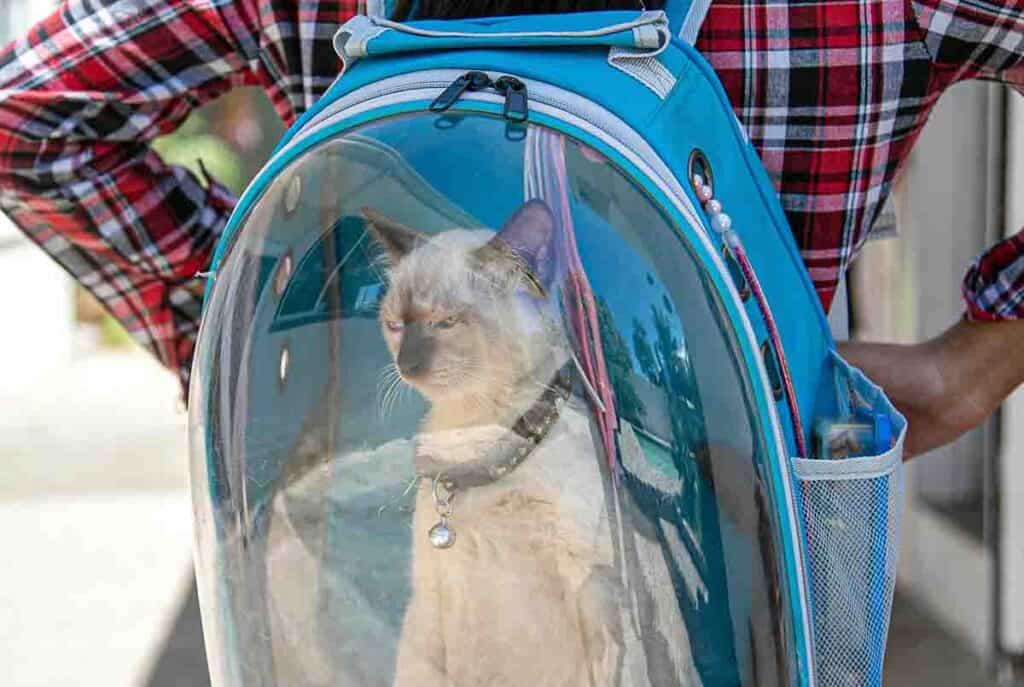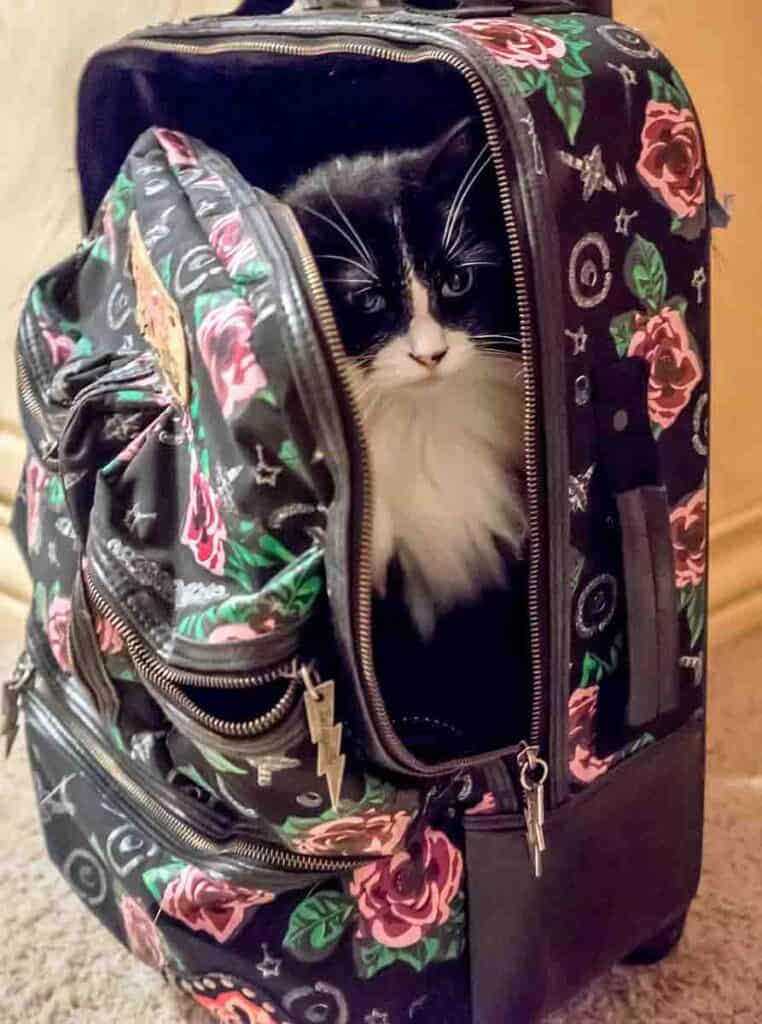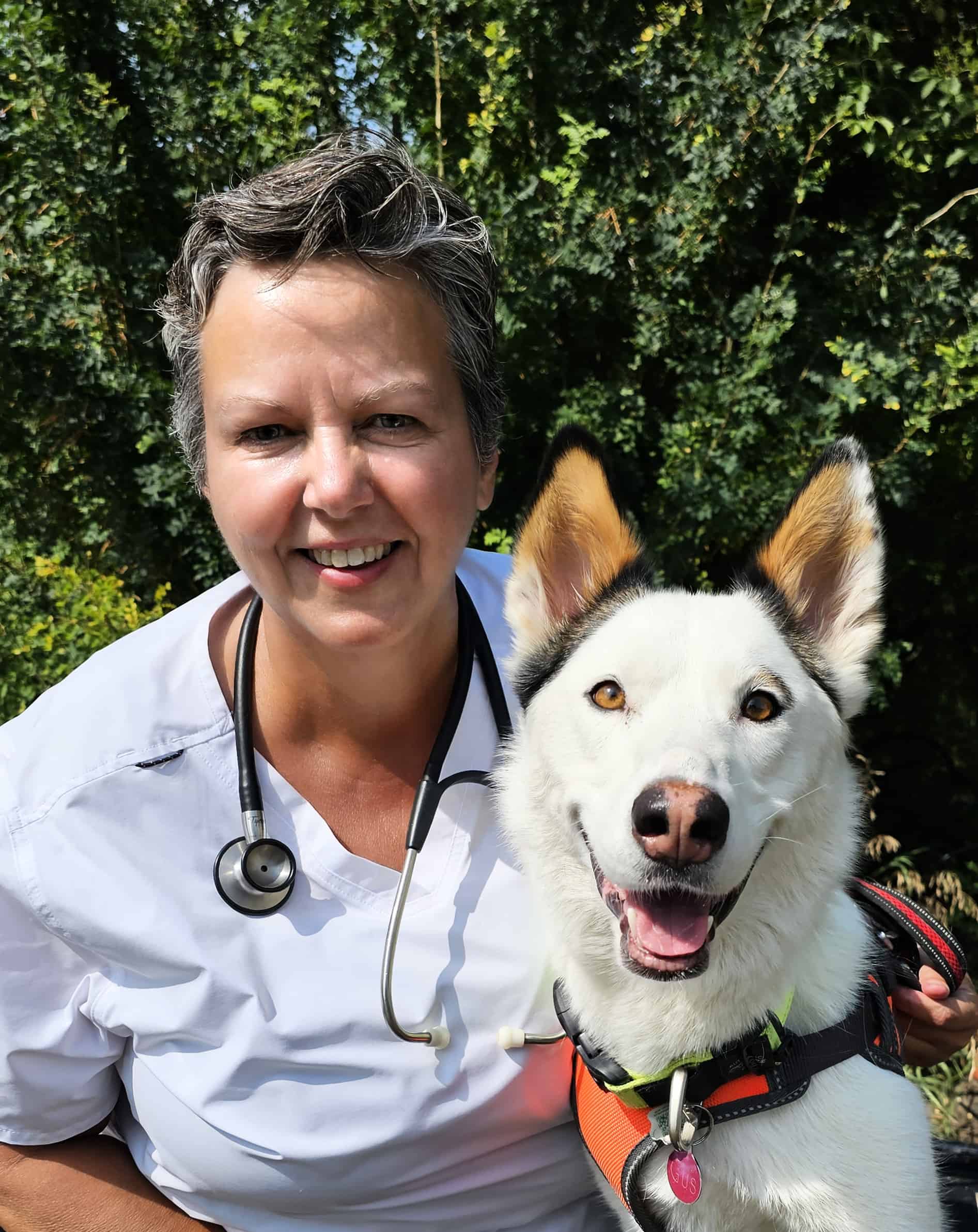If you’re planning a trip with your feline friend, you’ll want to be sure you have everything needed for a smooth and stress-free journey. But just what exactly is it that you need when you are traveling with a cat?
The length of your trip and mode of travel dictates what you need for traveling with a cat. Common necessities include a cat carrier, vaccine certificate, leash and harness, food and water, and portable litter box. You should also check ahead of time to make sure your accommodation is pet friendly.
We’ve put together the ultimate cat travel checklist to help make sure you don’t forget any of the essentials. From necessary documents to packing the right gear, this guide will help you ensure that you and your cat are well-prepared for a successful and enjoyable adventure together.
Pre-Travel Preparation
Preparing before you travel with your cat is extremely important. You don’t want to be caught in a situation where you don’t have the necessary documents or supplies needed for a successful journey.
Depending on the length of your trip, where your destination is, or how you will be traveling, there may be specific requirements that you need to meet before and during your journey.
Shorter journeys, of course, require less pre-travel preparation than long trips, plane travel, or crossing international borders. Not everything we discuss in this article will apply in every situation.
Veterinary Checkup
One of the essential steps you should take is to visit your veterinarian for a check-up before embarking on any travel plans, to ensure your cat can travel safely. This is also a good time to bring up any worries or questions you may have.
Your cat will be thoroughly checked by the vet to ensure they are healthy. This will include checking their weight, heart rate, temperature, and overall well-being.
During the visit to the vet, they will ensure that your cat’s vaccinations are current. If your cat is not up-to-date on its vaccinations, the vet may give them at that time.
Additionally, the vet will check your cat’s microchip to make sure that the contact information is current and accurate. This is essential in case your cat gets lost during your travels, as it will increase the chances of reuniting with your pet.
If your cat does not yet have a microchip, now is a good time to get one. Collars and identification tags can get lost, but a microchip is permanent.
Be sure to ask your vet for any other travel advice they may have as well. If your cat takes regular medications, make sure to have a sufficient supply to last the length of the trip. If your cat is an anxious traveler, ask your vet about medication to help calm them during the journey.
Travel Documentation
In addition to a health check-up, you will need to get the necessary travel documentation for your cat. Depending on where you are going, this may include a passport and/or health certificate.
A pet passport is a document that shows proof of vaccinations and other pertinent information about your pet. If you are traveling internationally, you may need to obtain a pet passport for your cat. Pet passports are required for travel between European Union countries.
A health certificate is a document that is written by your veterinarian and states that your cat has been examined and is healthy enough to travel. Depending on the country or state you are traveling to, you may need a health certificate in order for your cat to be allowed entry.
At a minimum, a rabies vaccine certificate is usually required to cross international borders.
It would be helpful to bring your cat’s ownership papers with you if you have those. These papers are important if your cat gets lost and you need to reclaim them.

Cat Carrier
No matter how long or short your trip is, you will need a cat carrier. Not only does it keep your cat safe and secure during the journey, but it can also provide them with a familiar and comfortable space if you get them used to it ahead of time.
When selecting a cat carrier for your travels, consider these features:
- Size and Comfort: Make sure the carrier is spacious enough for your cat to stand, turn around, and comfortably lie down. A carrier that’s too small can make your cat feel cramped and uncomfortable, while a carrier that’s too large can make them feel insecure.
- Durability and Security: Your cat carrier needs to be strong and able to provide protection during travel, in case of accidents or bumps. It should have a secure locking mechanism that is both easy to use and not prone to accidental opening or easy to pry open.
- Portability and Ease of Use: The carrier must be light and simple to transport and store. Some carriers have a handle or shoulder strap for convenience. Additionally, the carrier ought to be easy to clean and have removable, washable bedding along with a waterproof bottom.
- Airline Regulations: Before buying a carrier for air travel, check the airline’s regulations for size, type, and materials. Each airline has specific guidelines that the carrier must meet to be allowed on the plane.
Cat Travel Packing List
The secret to any successful trip is preparation, and the same goes for traveling with your cat. Here’s a list of items you can make your trip easier:
- Cat Carrier: As mentioned earlier, a cat carrier is a must-have item for traveling with your cat. Make sure the carrier is the right size for your cat and has all the features mentioned above.
- Identification: Make sure that your cat wears a collar with identification tags containing your name, phone number, and destination address. It’s also a good idea to bring a recent photo of your cat in case your cat gets lost.
- Harness and Leash: You will likely have to take your cat out of its carrier at some point. Cats often get scared in unfamiliar environments and are prone to dashing off. Having your cat on a leash and harness minimizes the chances of your cat getting lost.
- Health Certificate and Vaccination Records: If you are traveling by plane or internationally with your cat, you must present documentation of your cat’s vaccinations and a health certificate issued by your vet. Make sure you have copies of these documents with you.
- Food and Water: Bring enough food and water for your cat’s entire trip, including any layovers or delays. Pack food in an airtight container, and bring a bowl for your cat to eat and drink from.
- Medications: If your cat takes any medications, make sure you bring enough for the duration of the trip.
- Litter Box and Litter: Bring a portable litter box and enough litter for your cat to use during the trip. Disposable litter boxes are also available, which can be convenient for short trips.
- Comfort Items: Bring your cat’s favorite toys, blankets, and treats to help them feel more comfortable and at home during the journey.
- Cleaning Supplies: Accidents happen, so bring cleaning supplies such as paper towels and wet wipes, as well as a bag to put dirty material in.
- Calming Pheromone Spray: Synthetic feline pheromones can help reduce your cat’s stress and anxiety during travel and are highly recommended.
During Travel Checklist
When traveling with your cat, follow this checklist to ensure a smooth journey:
Check The Temperature
Make sure that the temperature in the car and carrier is not too hot or cold for your cat. Keep an eye on it, especially during long trips. Cat carriers that have lots of ventilation openings are good when temperatures may get uncomfortably warm.
You won’t have much choice about ambient temperature when traveling by plane, so having a carrier with good ventilation and blankets to keep your cat warm are both good ideas. Providing water in the form of ice can also help provide some relief when temperatures are warm.

Food, Water, And Litter Box Breaks
If you are traveling by vehicle, pull over regularly to provide bio breaks for yourself and your cat.
Offer your cat small amounts of food and water, and provide them access to a travel litter box.
Air travel requires a little more planning, as you are not allowed to take your cat out of its carrier while the plane is moving. Refer to our article “Tips on traveling with your cat on a plane” for advice on how to manage food, water, and potty breaks when traveling by air.
Keep Your Cat Entertained
Bring along your cat’s favorite toys, blankets, and bedding to help them feel comfortable and secure. You can also provide interactive toys or puzzle feeders to keep them mentally stimulated during the journey.
Calming Products
Consider using calming products like pheromone sprays to help your cat relax during the journey. Spray the inside of the carrier 15 minutes before placing your cat in it. It will wear off after several hours but don’t reapply it directly on your cat or spray it into the carrier while your cat is in it.
If you are not able to take the cat out to reapply the spray to the carrier, spray it on a cloth or blanket and put that in the carrier instead.
If your trip is long and your veterinarian has prescribed a sedative for your cat, then you may need to administer another dose. Again, if you are flying you cannot take your cat out of its carrier to give it medication so you need to plan accordingly.
Accommodation Checklist
Although we’ve left this item until the last, it really does need to be one of the first things that you do. One of the first steps in traveling with your cat is making sure that your destination accommodations are cat-friendly.
Many people traveling with their cats intend on staying with friends or relatives. Never assume that just because you are welcome that your cat is welcome too.
Always check with your host to make sure that it is okay to bring your cat and that their residence has no restrictions against cats in the building.
If you will be staying at a hotel, Airbnb, or even a camping site make sure to check their pet policy before booking. Some places may not allow pets or may have specific rules and regulations that you need to follow.
Don’t assume that if there is no obvious policy against pets then they are automatically allowed. Always look for a specific pet policy and, if you are in doubt, call the business to clarify.
When looking for rental/hotel accommodation, choose a location that is safe and secure for your cat. Avoid noisy or high-traffic areas that could cause it stress or anxiety.
Before you make your final selection, read reviews from other people who have brought their cats to stay at the accommodation. Look for comments about the staff’s attitude towards pets, the room’s cleanliness, and the guests’ overall experience.
Finally, be aware of any additional fees that may be associated with bringing your cat. Some accommodations may charge a pet fee or require a pet deposit which may or may not be refundable.
Conclusion
Traveling with a cat can be an exciting and rewarding experience for both you and your feline friend. At the very least, it doesn’t have to be a stressful one.
By taking the time to plan and prepare properly, you can ensure that your cat’s vacation is as enjoyable and comfortable as your own. Use our Ultimate Cat Travel Checklist to make sure you have everything you need before you hit the road.
We wish both of you a safe, happy, and stress-free journey. Bon voyage!



